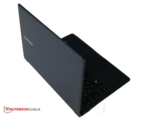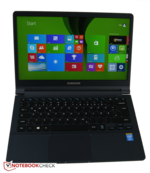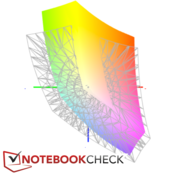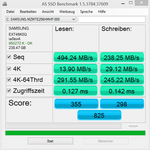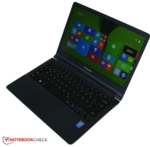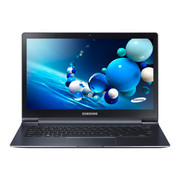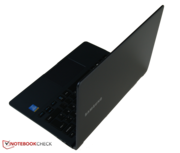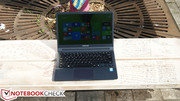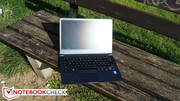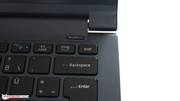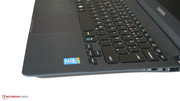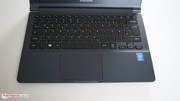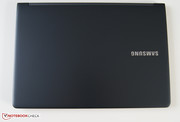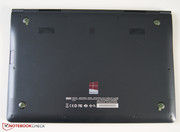Review Samsung ATIV Book 9 900X3G-K01DE Notebook

For the original German review, see here.
If the price of the Samsung ATIV Book 9 Plus is simply too high, prospective buyers can also opt for the more affordable ATIV Book 9. The Ultrabook is equipped with an Intel Haswell i5-4200U CPU and 8 GB of RAM. With a sticker price of 1150 Euro (~$1590) instead of 1500 Euro (~$2070), Samsung's Ultrabook comes with a 256 GB SSD and a regular Full-HD display with a resolution of 1980 x 1020 pixels instead of the QHD+ display. The single - albeit notable - advantage of the lower-resolution display: its panel is non-reflective.
Despite the fact that the price has dropped, the Ultrabook is still one of the more expensive ones out there and accordingly, our expectations are set pretty high as well. Since the construction of the ATIV Book 9 is identical to the Plus-model, we are going to focus mostly on the differences - for details, please take a look at the previous review.
For comparison purposes, we look at the similarly equipped competitors Fujitsu Lifebook U554 and Asus Zenbook UX302LA.
Case
Although the chassis visually appears to be identical to the Lite-version of the Ultrabook, the new ATIV Book is actually made from upscale-looking aluminum. The dark and matte surface areas are non-slip and robust. The Book 9 lacks the chrome trim of the ATIV Book 9 Plus.
The chassis has been revised and the surfaces appear to be less susceptible to fingerprints. Access to the components remains unchanged, and the the bottom cover attaches to the aluminum base unit with 10 screws. Just like on the ATIV Book 9 Plus, the display of the review Ultrabook opens easily and smoothly thanks to the hinge design. The maximum opening angle is not as generous though and not even close to the 180 degrees of the Plus-version. The hinge covers are plastic, so the material selection is not entirely uniform. A check of the dimensions reveals that the ATIV book is now even slimmer at 13.2 mm thick; the weight has decreased to 1.12 kg. These are exceptional numbers in this category, which make the 13.3-inch Ultrabook stand out even more. The competition can't compare here: the Fujitsu Lifebook U554) is 17.5 and the Asus Zenbook UX302LA 21 mm thick.
Despite the thin and light chassis, Samsung's Ultrabook appears to be quite sturdy and as such well suited as a mobile companion.
Connectivity
Since the review notebook shares the same motherboard as well as other hardware with the Plus-version, one might think that both Ultrabooks come with the same ports - but that's actually not the case. The right edge of the new model is home to a microphone and a USB 2.0 port, whereas the Samsung ATIV Book 9 Plus is equipped with a USB 3.0 port instead. This might be a somewhat limiting factor since it requires the user to consider the location of the ports during use.
Accessories
No real changes as far as the accessories are concerned. We appreciate the fact that Samsung includes an Ethernet adapter instead of making it an option that costs extra.
Input Devices
Keyboard
We really liked the superb black chiclet keyboard Samsung equipped the ATIV Book 9 Plus with. For the ATIV Book 9, Samsung unfortunately cut costs and while the keyboard is generally still very smooth, the keys rattle and are very noisy during typing. It seems to us that the keys are a little on the loose side and move around too much.
Display
The biggest difference between the review model and the Plus-version is the display. For 350 Euro (~$480) less, the ATIV Book 9 comes with a Full-HD TN panel with a resolution of 1980 x 1020 pixels instead of the QHD+ touch display with 3200 x 1800 pixels. From a quality standpoint, the TN panel is not in the same league as the QHD+ panel, but because it is non-glare, it is suited better for outdoor use. In addition to the anti-glare treatment, the average brightness is also quite a bit higher at 352 cd/m² - the Plus-version topped out at 284.3 cd/m². The Fujitsu Lifebook U554 can't compete on resolution (1366 x 768 pixels), nor brightness (less than 200 cd/m²) and only takes the third place in our comparison. The Asus-Zenbook-UX302LA features a matte display and the same resolution, but the average brightness is lower by about 50 nits. The display of the ATIV Book 9 maintains its maximum brightness of 379 cd/m² also when running on battery power.
A significant drawback is display bleeding. As the photo clearly shows, the white areas are quite noticeable and can be annoying during dark scenes in movies or during gaming - not something we are very happy about considering the notebook retails for more than 1000 Euro (~$1400).
| |||||||||||||||||||||||||
Brightness Distribution: 83 %
Center on Battery: 379 cd/m²
Contrast: 948:1 (Black: 0.4 cd/m²)
ΔE ColorChecker Calman: 4.28 | ∀{0.5-29.43 Ø4.78}
ΔE Greyscale Calman: 3.96 | ∀{0.09-98 Ø5}
54.78% AdobeRGB 1998 (Argyll 1.6.3 3D)
61.8% AdobeRGB 1998 (Argyll 3D)
84.7% sRGB (Argyll 3D)
65.8% Display P3 (Argyll 3D)
Gamma: 2.35
CCT: 7768 K
| Samsung ATIV Book 9 900X3G-K01 HD Graphics 4400, 4200U, Samsung PM851 Series MZMTE256HMHP | Samsung ATIV Book 9 Plus HD Graphics 4400, 4200U, Samsung MZNTD128HAGM | Fujitsu Lifebook U554 HD Graphics 4400, 4200U, Samsung SSD 840 250GB MZ7TD256HAFV | Asus Zenbook UX302LA-C4003H HD Graphics 4400, 4200U, Hitachi Travelstar Z5K500 HTS545050A7E680 + 24 GB SanDisk SSD U100 Cache | |
|---|---|---|---|---|
| Display | -40% | -3% | ||
| Display P3 Coverage (%) | 65.8 | 36.04 -45% | 60.3 -8% | |
| sRGB Coverage (%) | 84.7 | 54 -36% | 83.8 -1% | |
| AdobeRGB 1998 Coverage (%) | 61.8 | 37.27 -40% | 61 -1% | |
| Screen | -8% | -76% | -10% | |
| Brightness middle (cd/m²) | 379 | 301 -21% | 226 -40% | 322 -15% |
| Brightness (cd/m²) | 352 | 284 -19% | 199 -43% | 296 -16% |
| Brightness Distribution (%) | 83 | 84 1% | 81 -2% | 86 4% |
| Black Level * (cd/m²) | 0.4 | 0.39 2% | 0.88 -120% | 0.52 -30% |
| Contrast (:1) | 948 | 772 -19% | 257 -73% | 619 -35% |
| Colorchecker dE 2000 * | 4.28 | 4 7% | 9.99 -133% | 3.55 17% |
| Greyscale dE 2000 * | 3.96 | 4.4 -11% | 10.43 -163% | 4.35 -10% |
| Gamma | 2.35 94% | 2.43 91% | 2.63 84% | 2.55 86% |
| CCT | 7768 84% | 7434 87% | 12905 50% | 6856 95% |
| Color Space (Percent of AdobeRGB 1998) (%) | 54.78 | 54.8 0% | 36.1 -34% | 57 4% |
| Total Average (Program / Settings) | -8% /
-8% | -58% /
-66% | -7% /
-8% |
* ... smaller is better
In addition to increasing the brightness, Samsung also improved the contrast and the black value is correspondingly quite low at 0.4 cd/m². The competing notebooks are not able to match these results, although Samsung's ATIV Book 9 Plus slightly outperforms the review notebook. Subjectively, the noticeable display bleeding is quite distracting, as the black bars are anything but when watching movies. Colors are saturated and even, although the color temperature of 7312 K is pretty far from the ideal of 6500 K. The CalMAN analysis reveals a very low DeltaE deviation for the gray levels of 3.96 average. The Samsung ATIV Book 9 takes the first place here in our internal comparison; the Fujitsu Lifebook U554 has the worst result with a DeltaE of over 10. With a DeltaE of 4.28, The color accuracy is not quite as good: with a DeltaE of 4.28, the review notebook is bested by the Plus-version and the Asus-Zenbook-UX302LA (DeltaE values of 4 and 3.55, respectively).
Overall, the display of the ATIV Book 9 is quite impressive. An ICC comparison with Argyll does show that the display doesn't live up to professional standards, however, as the sRGB coverage is low at 74.77 %. The coverage of the Adobe RGB 1998 color space is consequently even lower at 54.78 %.
Because of the high maximum brightness and the fact that the panel is non-glare, the Samsung's Ultrabook can also be used outdoors without major restrictions. Subnotebooks are generally designed to be highly mobile and should thus work well in bright environments. Both the Asus-Zenbook-UX302LA as well as the Plus-version come with a glossy display, which can limited usability outdoors.
The vividness of the colors and the brightness change comparatively little at various viewing angles. Even at 45 degrees, the screen content is easy to see, although there is of course some decrease in color intensity. Overall viewing angle stability is decent and not a limiting factor during daily use, although the display can't be compared to high-end IPS panels like the one Samsung uses for the Plus-version.
Performance
Both the review notebook and the Samsung ATIV Book 9 Plus use the same CPU and graphics card. The Haswell Intel Core i5-4200U CPU is known for its very low TDP of 15 watts and therefore very well suited for subnotebooks. Samsung also increased the RAM from 4 to 8 GB and outfits the new Ultrabook with a 256 GB SSD. The selected hardware components seem to be a good fit for a subnotebook.
Processor
All four competing notebooks are equipped with the same processor - a Haswell-generation Intel Core i5-4200U. The dual-core CPU, which has a core frequency of 1.6 GHz and a Turbo-induced maximum of 2.3 GHz (both cores), was specifically designed for Ultrabooks. A analysis of the performance shows that all competing notebooks are virtually identical as far as their Cinebench R11.5 scores are concerned with only the Fujitsu Lifebook U554 falling out of line a little. The CPU frequency never dropped below the base clock speed, while the Turbo was not always able to maintain the maximum clock rate, either.
With the notebook running on battery, the Turbo was not active, although the test results didn't suffer much as a consequence.
System Performance
The results of the PCMark 7 benchmark test are also almost identical to the higher-end ATIV Book 9 Plus. The difference is more or less negligible and can be attributed to environmental differences like ambient temperature and other similar factors. With a result of 4898 points, the review notebook decidedly outperforms the Asus-Zenbook-UX302LA (3320 points). Subjectively, the combination of SSD with Intel Core i5 CPU works well and results in a very speedy system overall.
Storage Devices
Although it's apparent that Samsung cut some costs with the display, the hard drive has actually grown in size. The 256 GB SSD of the review notebook is definitely more usable than the 128 GB version installed in the Plus model of the series. In addition to the size of the drive, the write speeds have also improved by an average of 100 MB (sequential write). Those interested in even more storage should take a look at the Asus Zenbook UX302LA, which is equipped with a hybrid drive and offers almost twice as much space.
GPU Performance
The integrated Intel HD Graphics 4400 is part of Intel's Haswell architecture and handles the graphics output of all the notebooks in our comparison. As we already mentioned, the TDP is a very low 15 watts, since the CPU was primarily designed for mobility.
The Samsung ATIV Book 9 scored 5039 points when we tasked it with the 3DMark06 benchmark test, which is 700 points less than the Plus-version and 1000 points less than the Asus-Zenbook-UX302LA. The results for the 3DMark Vantage benchmark are similar: 3738 points is about 300 points less than the other two candidates - despite the identical graphics unit.
Compared to other Ultrabooks in this category, the results are about average and not out of the ordinary. When we performed the benchmark tests with the review notebook running on battery, the results were either identical or just ever so slightly different.
| Samsung ATIV Book 9 900X3G-K01 HD Graphics 4400, 4200U, Samsung PM851 Series MZMTE256HMHP | Samsung ATIV Book 9 Plus HD Graphics 4400, 4200U, Samsung MZNTD128HAGM | Fujitsu Lifebook U554 HD Graphics 4400, 4200U, Samsung SSD 840 250GB MZ7TD256HAFV | Asus Zenbook UX302LA-C4003H HD Graphics 4400, 4200U, Hitachi Travelstar Z5K500 HTS545050A7E680 + 24 GB SanDisk SSD U100 Cache | |
|---|---|---|---|---|
| 3DMark 06 | ||||
| 1280x1024 Standard Score AA:0x AF:0x (Points) | 5037 | 5751 14% | 6039 20% | |
| 3DMark Vantage | ||||
| 1280x1024 P Result (Points) | 3738 | 4046 8% | 2450 -34% | 4095 10% |
| 3DMark 11 | ||||
| 1280x720 Performance (Points) | 886 | 931 5% | 952 7% | |
| Total Average (Program / Settings) | 9% /
9% | -34% /
-34% | 12% /
12% |
| 3DMark 06 Standard Score | 5037 points | |
| 3DMark Vantage P Result | 3738 points | |
| 3DMark 11 Performance | 886 points | |
Help | ||
Gaming Performance
We use the different gaming benchmarks to determine if the notebook is suitable for casual gaming. Given the hardware, high-end gaming is definitely out of the question.
During the first test, we compare the frame rates for the game Anno 2070. The Samsung Ultrabook managed an average frame rate of 51.37 fps with the settings on low, which is certainly acceptable. Despite the identical GPU, the frame rate of the ATIV Book 9 Plus was higher by about 10 fps. BioShock Infinite - with the settings on low - returned a frame rate of 33 fps, which means the game is playable without any stuttering. With 36.9 fps, the ATIV Book 9 achieved a higher frame rate than the Plus-version for Total Rome II, although the Asus-Zenbook-UX302LA managed to be faster still at 42.7 fps. Although the performance is slightly behind the competitors, it's still about average for the Intel HD 4400 and as such not a reason for concern.
Despite the identical GPU and twice as much RAM, the review model doesn't score as well as the ATIV Book 9 Plus. We are not quite sure if this is due to the newer Intel drivers or other system variables.
| Samsung ATIV Book 9 900X3G-K01 HD Graphics 4400, 4200U, Samsung PM851 Series MZMTE256HMHP | Samsung ATIV Book 9 Plus HD Graphics 4400, 4200U, Samsung MZNTD128HAGM | Asus Zenbook UX302LA-C4003H HD Graphics 4400, 4200U, Hitachi Travelstar Z5K500 HTS545050A7E680 + 24 GB SanDisk SSD U100 Cache | |
|---|---|---|---|
| Dota 2 | |||
| 1024x768 Low / Off, Render Quality: 40 % (fps) | 30.3 | 54.5 80% | |
| Total War: Rome II | |||
| 1024x768 Low Preset (fps) | 36.9 | 34.7 -6% | 42.7 16% |
| Anno 2070 | |||
| 1024x768 Low Preset (fps) | 51.4 | 62.5 22% | |
| Total Average (Program / Settings) | 32% /
32% | 16% /
16% |
| low | med. | high | ultra | |
|---|---|---|---|---|
| Anno 2070 (2011) | 51.4 | 28.8 | 17.6 | 7.7 |
| BioShock Infinite (2013) | 33.1 | 17.6 | 15.4 | 5 |
| Dota 2 (2013) | 30.3 | 21.5 | ||
| Total War: Rome II (2013) | 36.9 | 27.4 | 20.2 | 6.8 |
Emissions
System Noise
Subnotebooks are expected to deliver a lot of performance even though they are thin and compact. The heat that is generated has to be removed with passive and active measures. Despite the rather slim dimensions, the Samsung ATIV Book 9 does well as far as the system noise is concerned - at least during normal use. During idle, the Ultrabook is barely audible at 30.3 dB. The maximum of 42.7 dB is also still acceptable. Users who want a quiet system but frequently subject their notebooks to high load levels might want to consider the Asus-Zenbook-UX302LA, which never surpasses 34.5 dB even under maximum load.
Noise level
| Idle |
| 30.3 / 30.3 / 31.7 dB(A) |
| Load |
| 39.8 / 42.7 dB(A) |
 | ||
30 dB silent 40 dB(A) audible 50 dB(A) loud |
||
min: | ||
Temperature
A look at the surface temperatures reveals nothing out of the ordinary. The Ultrabook can be used on the lap during normal usage without any caveats. The palm rest and the keyboard keys remain very cool most of the time; only during high-load scenarios the upper area of the keyboard got a little warm to the touch.
During maximum system stress (both CPU and GPU), the CPU frequency dropped to 1250 MHz, which is below the nominal clock speed of 1.6 GHz. The maximum core temperature didn't exceed 77 degrees C at this point, which is quite low. This frequency drop does not really impact performance, as the benchmark scores above clearly indicate.
(-) The maximum temperature on the upper side is 45.6 °C / 114 F, compared to the average of 35.9 °C / 97 F, ranging from 21.4 to 59 °C for the class Subnotebook.
(+) The bottom heats up to a maximum of 39 °C / 102 F, compared to the average of 39.3 °C / 103 F
(+) In idle usage, the average temperature for the upper side is 24.3 °C / 76 F, compared to the device average of 30.8 °C / 87 F.
(+) The palmrests and touchpad are cooler than skin temperature with a maximum of 28.2 °C / 82.8 F and are therefore cool to the touch.
(±) The average temperature of the palmrest area of similar devices was 28.2 °C / 82.8 F (0 °C / 0 F).
Speakers
Considering this is a compact subnotebook, we shouldn't expect a premium sound system. The stereo speakers located on the bottom do sound quite decent, however, and are even capable of producing some lower frequencies. Of course, demanding users should opt for external speakers or headphones instead.
Energy Management
Power Consumption
During idle, the Samsung ATIV Books 9 consumes between 2.9 and 8.9 watts, which is slightly less than the ATIV Book 9 Plus and all the other competitors mentioned above. Under maximum load, the Ultrabook requires about 30 watts, which is 10 watts less than what the small power adapter, which is rated for 40 watts, can supply.
| Off / Standby | |
| Idle | |
| Load |
|
Key:
min: | |
Battery Life
In idle mode, the Plus-version of the Ultrabook ran out of battery 2 hours sooner than the less expensive ATIV Book 9. A time of 13 hours and 53 minutes is a very good result - only the Fujitsu Lifebook U554 did better and lasted an hour longer.
Our WLAN test simulates surfing the web. The review model managed 5 hours and 43 minutes, which is about half an hour less than the Plus-version, but still a decent result.
Under load, the results are reversed again and with a run time of 2 hours and 28 minutes, the 900X3G was only beaten by the Fujitsu Lifebook U554, which lasted an additional 10 minutes.
Verdict
The middle version of the ATIV Book 9 series is a pretty compelling package overall - something we should expect given the rather steep price of 1150 Euro (~$1590). Some prospective buyers might have issues with the screen, as the panel is using TN and not IPS technology and additionally suffers from display bleeding. Although the introductory price of the new ATIV Book is significantly lower (by 350 Euro / ~$480) than the initial price of the Plus-version, the latter can now be found for around 1200 Euro (~$1660), albeit with a 128 GB SSD. Those who'd rather have a high-resolution QHD+ display instead of the larger SSD and 4 GB additional RAM, should consider this model as an alternative.




